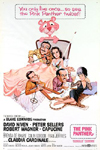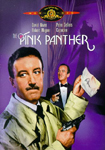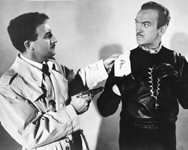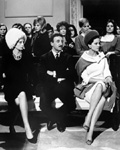Synopsis
"As with a surprising number of film roles so closely associated with a particular actor, the Inspector Clouseau
character that made his debut in The Pink Panther (1964) was not originally intended for Peter Sellers and was not,
in fact, meant to be the central role. The Pink Panther was conceived as a sophisticated comedy about a
charming, urbane jewel thief, Sir Charles Litton, a part perfectly suited to the talents and image of David Niven.
Years before this picture, Niven nailed the character in Raffles (1940) as the upper crust man-about-town who
leads a double life as an ace jewel thief. But any hopes of capitalizing on his previous success were quickly
dashed when Sellers arrived on the set.

 Peter Ustinov was originally cast as Clouseau, with Ava Gardner as his faithless wife in league with Litton.
When Gardner backed out, Ustinov left the project, too, and director Blake Edwards turned to Sellers, a
chameleon-like British comic actor known for his ability to transform himself into the most outrageous characters
- sometimes playing more than one in a single picture, as he had already proven in The Mouse That Roared (1959) and
would do so again in Dr. Strangelove (1964). The Pink Panther sparked a number of sequels, but Clouseau was
the main character, not Sir Charles. Instead, Niven had to content himself with playing a variation on the
character in the TV series, The Rogues (1964-65).
Peter Ustinov was originally cast as Clouseau, with Ava Gardner as his faithless wife in league with Litton.
When Gardner backed out, Ustinov left the project, too, and director Blake Edwards turned to Sellers, a
chameleon-like British comic actor known for his ability to transform himself into the most outrageous characters
- sometimes playing more than one in a single picture, as he had already proven in The Mouse That Roared (1959) and
would do so again in Dr. Strangelove (1964). The Pink Panther sparked a number of sequels, but Clouseau was
the main character, not Sir Charles. Instead, Niven had to content himself with playing a variation on the
character in the TV series, The Rogues (1964-65).
 Set in a fashionable resort in the Italian Alps, the story of The Pink Panther centers on Litton's attempt to steal
a magnificent gem from the visiting Princess Dala. Unknown to the others, Litton is actually the legendary
Phantom, a notorious thief whose myth is adored by women and envied by men. For years, French Inspector
Clouseau has been hot on the trail of the Phantom, who always manages to elude capture at the last minute.
That's because his mistress and accomplice is Clouseau's wife, and the bungling inspector is too dim to
ever conceive of such a ploy. Complicating matters is Litton's American-born nephew George, a collegiate
playboy who secretly aspires to follow in his uncle's footsteps, and Dala's own efforts to conceal the jewel for
legal reasons. When the gem is stolen by two thieves disguised as gorillas, Clouseau closes in on his prey.
Thinking he's caught the crook at last, the detective finds the tables turned when the case goes to trial.
The gem has been planted on him and he is convicted, but contrary to feeling humiliated and defeated, Clouseau
goes off to prison delighted to be mistaken for the Phantom, the legend all women desire and all men admire.
Set in a fashionable resort in the Italian Alps, the story of The Pink Panther centers on Litton's attempt to steal
a magnificent gem from the visiting Princess Dala. Unknown to the others, Litton is actually the legendary
Phantom, a notorious thief whose myth is adored by women and envied by men. For years, French Inspector
Clouseau has been hot on the trail of the Phantom, who always manages to elude capture at the last minute.
That's because his mistress and accomplice is Clouseau's wife, and the bungling inspector is too dim to
ever conceive of such a ploy. Complicating matters is Litton's American-born nephew George, a collegiate
playboy who secretly aspires to follow in his uncle's footsteps, and Dala's own efforts to conceal the jewel for
legal reasons. When the gem is stolen by two thieves disguised as gorillas, Clouseau closes in on his prey.
Thinking he's caught the crook at last, the detective finds the tables turned when the case goes to trial.
The gem has been planted on him and he is convicted, but contrary to feeling humiliated and defeated, Clouseau
goes off to prison delighted to be mistaken for the Phantom, the legend all women desire and all men admire.

 In a way, that ending relates to Peter Sellers' own life story. A pudgy man with a somewhat hang-dog face,
Sellers rose to prominence as a member of the ensemble of the anarchic British radio program The Goon Show (1951-60),
where he first developed his ability to vocally create a wide range of bizarre characters. He also appeared
in a number of British film comedies, among them The Ladykillers (1955), where he absorbed the influence of Alec
Guinness, and I'm All Right, Jack (1959), another picture offering multiple roles. But Sellers longed to be a
handsome and desirable leading man. He could perform rings around someone like his Pink Panther co-star Robert
Wagner, yet he desperately envied the young actor's looks. Prior to filming The Pink Panther, Sellers had his
teeth straightened and capped and subjected himself to a grueling weight-loss regimen that included the excessive use
of diet pills, possibly a contributing factor to the heart attack he suffered before the film's release. (Plagued
by a bad heart most of his life, he eventually succumbed to it at the age of 54 in 1980.) So it must have been
gratifying for him to be the center of Edwards' complete attention on the set of The Pink Panther as the two worked
together - much to Niven's dismay and disappointment - to create and expand a character that would achieve worldwide
popularity in four more Clouseau movies over the next 15 years, and one, Trail of the Pink Panther (1982), that
Edwards hobbled together from old footage after Sellers' death.
In a way, that ending relates to Peter Sellers' own life story. A pudgy man with a somewhat hang-dog face,
Sellers rose to prominence as a member of the ensemble of the anarchic British radio program The Goon Show (1951-60),
where he first developed his ability to vocally create a wide range of bizarre characters. He also appeared
in a number of British film comedies, among them The Ladykillers (1955), where he absorbed the influence of Alec
Guinness, and I'm All Right, Jack (1959), another picture offering multiple roles. But Sellers longed to be a
handsome and desirable leading man. He could perform rings around someone like his Pink Panther co-star Robert
Wagner, yet he desperately envied the young actor's looks. Prior to filming The Pink Panther, Sellers had his
teeth straightened and capped and subjected himself to a grueling weight-loss regimen that included the excessive use
of diet pills, possibly a contributing factor to the heart attack he suffered before the film's release. (Plagued
by a bad heart most of his life, he eventually succumbed to it at the age of 54 in 1980.) So it must have been
gratifying for him to be the center of Edwards' complete attention on the set of The Pink Panther as the two worked
together - much to Niven's dismay and disappointment - to create and expand a character that would achieve worldwide
popularity in four more Clouseau movies over the next 15 years, and one, Trail of the Pink Panther (1982), that
Edwards hobbled together from old footage after Sellers' death.
 In the end, the international success he achieved with The Pink Panther and its even more hilarious follow-up, A Shot
in the Dark (1964), turned out to be something of a curse for Peter Sellers. Plagued by a series of flops in
the early 1970s, he reluctantly came back to the character in The Return of the Pink Panther (1974) and two others
after that, mostly for the money. A delight to work with when he was challenged by a role, he became increasingly
difficult to handle as Clouseau. Fortunately, he finally achieved the respect he longed for as an actor shortly
before his death. He was nominated for an Oscar for his performance in Being There (1979), a role he pursued
for years by sending marathon telegrams to author Jerzy Kosinski signed "Chance the Gardener," his character's name.
In the end, the international success he achieved with The Pink Panther and its even more hilarious follow-up, A Shot
in the Dark (1964), turned out to be something of a curse for Peter Sellers. Plagued by a series of flops in
the early 1970s, he reluctantly came back to the character in The Return of the Pink Panther (1974) and two others
after that, mostly for the money. A delight to work with when he was challenged by a role, he became increasingly
difficult to handle as Clouseau. Fortunately, he finally achieved the respect he longed for as an actor shortly
before his death. He was nominated for an Oscar for his performance in Being There (1979), a role he pursued
for years by sending marathon telegrams to author Jerzy Kosinski signed "Chance the Gardener," his character's name.
 As for Niven, he so resented having the picture stolen from him that in later years as a presenter of an Academy Award,
he asked the orchestra conductor not to use Mancini's music to introduce him but to play the theme from his earlier hit
Around the World in 80 Days (1956). The one lasting anecdote Niven carried from the filming of The Pink Panther
was related in his autobiography The Moon's a Balloon (Dell, 1973). While other scenes were being shot, Niven
went skiing in 35-degrees-below-zero weather. On his way down the slopes, he got frostbite on a very private
part of his anatomy. He was forced to thaw the frozen appendage by dipping it painfully in a glass of brandy.
It's a story worthy of Clouseau himself.
As for Niven, he so resented having the picture stolen from him that in later years as a presenter of an Academy Award,
he asked the orchestra conductor not to use Mancini's music to introduce him but to play the theme from his earlier hit
Around the World in 80 Days (1956). The one lasting anecdote Niven carried from the filming of The Pink Panther
was related in his autobiography The Moon's a Balloon (Dell, 1973). While other scenes were being shot, Niven
went skiing in 35-degrees-below-zero weather. On his way down the slopes, he got frostbite on a very private
part of his anatomy. He was forced to thaw the frozen appendage by dipping it painfully in a glass of brandy.
It's a story worthy of Clouseau himself.
 Oh, and just to clear up any confusion about the title once and for all, the jewel is called the Pink
Panther. Because of Sellers' dominance of the picture, the catchy animated title sequence, and Henry
Mancini's unforgettable theme music, the name became so strongly connected to Clouseau that it was
used in all but one of the titles in the rest of the series, whether the jewel was part of the plot
or not."
Oh, and just to clear up any confusion about the title once and for all, the jewel is called the Pink
Panther. Because of Sellers' dominance of the picture, the catchy animated title sequence, and Henry
Mancini's unforgettable theme music, the name became so strongly connected to Clouseau that it was
used in all but one of the titles in the rest of the series, whether the jewel was part of the plot
or not."
Commentary
This is a perfect screwball comedy. But it also has a certain flair to it - 1960's, european setting,
international jewel thief. Made nearly a decade after Hitchcock's
"To Catch A Thief" (another of my favorites),
this movie uses many of the same elements, only with more of a comic twist. The cast is excellent and
the comedy, while dated and often predictable, still makes me laugh. It's a feel-good movie from start
to finish.

|














